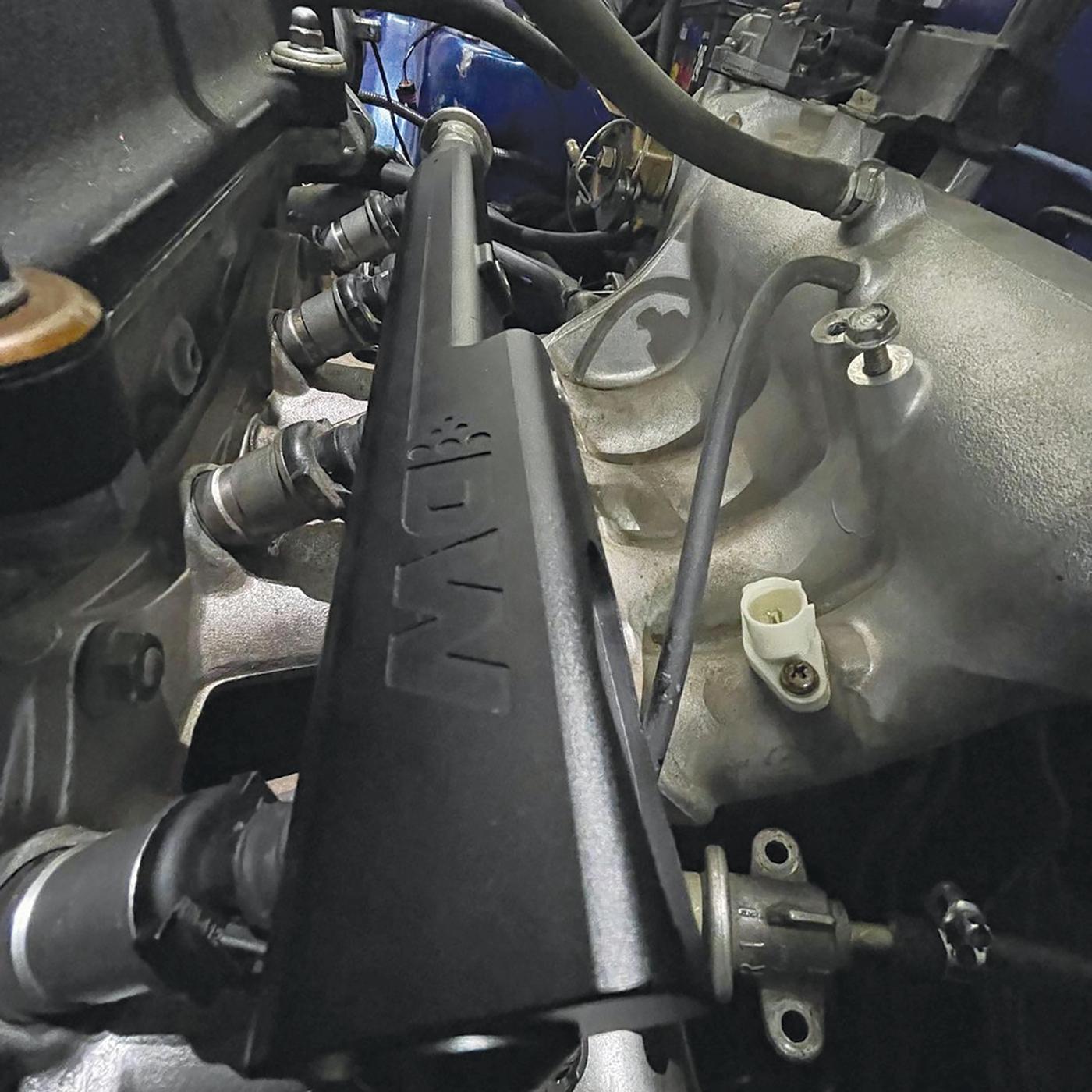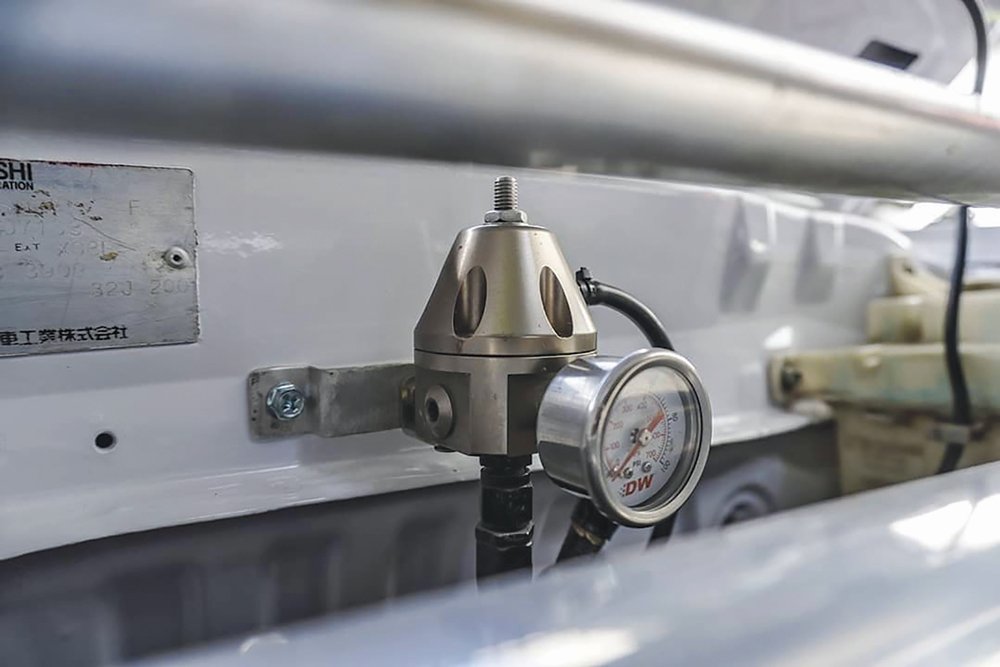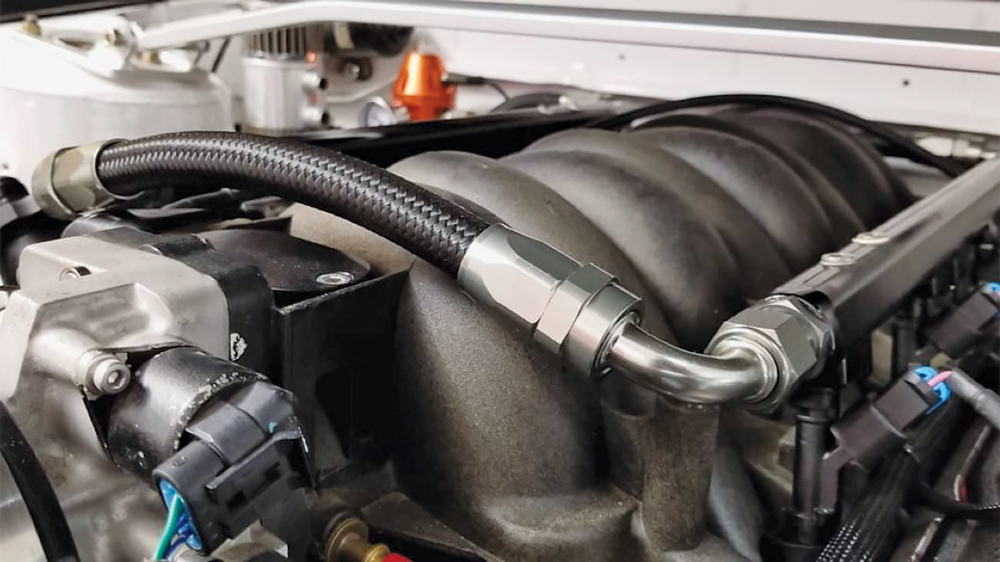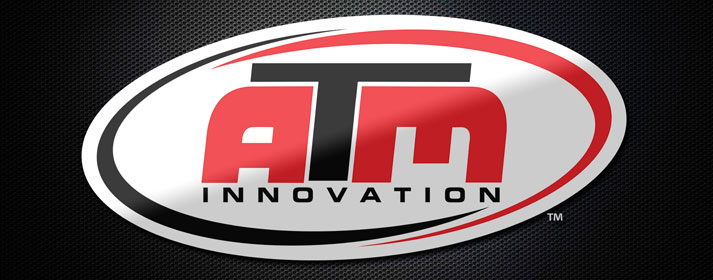PRI EDUCATION: CONVERTING FROM PUMP GAS TO E85

When building a proper E85 fuel system, it’s important to select an injector size that meets the flow requirements while maintaining a 90% or lower duty cycle.
CONSIDER THESE IMPORTANT FACTORS BEFORE MOVING TO E85, INCLUDING HOW TO CARE FOR YOUR FUEL SYSTEM AFTER THE FACT.
There are many options to choose from beyond standard pump gas when fueling a high-performance engine, including 93-octane pump gas, ethanol blends, methanol, and myriad race gas options. Like every other decision made when building a race car, each option has advantages and disadvantages, and the build team decides what will work best given the project budget and objectives. One option that has skyrocketed in popularity over the last decade is E85, a blend of 15% gasoline and 85% ethanol. This article will give a basic overview of the advantages and disadvantages of E85, guidelines for components and tuning, and some best practice suggestions for E85 fuel system maintenance.
WHY CHOOSE E85?
The performance advantage of E85 versus pump gas lies in its octane rating and its cooling effect on the intake charge. True E85 has an octane rating of 105. The RON component of the R+M/2 octane rating is particularly high, meaning E85 is resistant to knock, which allows increased timing advance and boost pressure. In addition, the ethanol component of E85 extracts heat from the intake charge as it transitions from a liquid to a vapor phase. This cooling effect creates a dense, oxygen-rich intake charge that increases combustion energy. There are also two significant practical advantages with E85 from the pump: affordability and convenience. Pump E85 is easy to find at many retail filling stations throughout the Midwest, and with a bit of searching can be found throughout most of the US. If there is a need for a search, it is worth the effort because pump E85 is a performance bargain. At a current national average of $3.09 per gallon at the pump, E85 costs less than even the cheapest low octane gasoline.
DOES E85 HAVE ANY DISADVANTAGES?
One of the most significant issues when using pump E85 is that the concentration of ethanol can vary significantly. The term “E85” can be a misnomer because the standards organization ASTM International allows fuels with ethanol concentrations as low as 51% to carry the E85 label. Inconsistent fuel properties can have catastrophic effects on a tuned performance engine. Another point to consider is the hygroscopic nature of ethanol. Ethanol readily pulls moisture from the air, so E85 may be “watered down” if not transported and stored correctly by the fuel retailer. Water can also accumulate in a vehicle’s fuel tank if left at a low fuel level for an extended period, especially in a humid environment. It’s also important to remember that ethanol has high corrosivity and low lubricity, which together can lead to premature wear of fuel system and engine components. Lastly, the energy density of E85 is significantly less than standard gasoline. This means fuel economy will be reduced, and injectors and the fuel pump might need an upgrade (more on this below).

PUMP E85 VS. E85 RACE FUEL
The rise in popularity of E85 has taken place at the pump and through traditional race fuel manufacturers like VP Racing, Sunoco, Ignite, and others. As mentioned, two disadvantages of pump E85 are the inconsistency in ethanol concentration and the risk of water in the fuel. However, both are essentially non-issues for racers going the E85 race fuel route. E85 race fuels have an 85% ethanol concentration every time. However, this quality and consistency come at a high price. E85 race fuels typically cost $8–$12 per gallon and can be challenging to find, transport, and store. This makes the allure of easily accessible pump E85 at the cost of $3 per gallon hard to pass up.
BUILDING AN E85 COMPATIBLE FUEL SYSTEM
Building a proper E85 fuel system will take advantage of all the performance benefits of pump E85 while mitigating the risks. Flow capacity, material compatibility, tuning, and maintenance are the biggest considerations.
Fuel System Capacity
The lower energy density of E85 requires 30–40% increased flow from the fuel system to maintain proper lambda. Usually, fuel injectors and fuel pumps—and occasionally fuel lines—need to be upgraded to increase flow. Selecting an injector size that meets the flow requirements while maintaining a 90% or lower duty cycle is recommended. It is also recommended to have 10–20% headroom on the fuel pump. Technical support from a quality fuel systems manufacturer or retailer, or a consult with an engine tuner, should help in choosing the right components.
General Material Compatibility
The high corrosivity, low lubricity, and hygroscopic nature of E85 can wreak havoc on an ill-equipped fuel system since what works for gasoline does not necessarily work for E85. Materials to avoid are PVC, nitrile, natural rubber, urethane, non-anodized aluminum, zinc, brass, and any untreated ferrous metals. In general, OE fuel systems in vehicles manufactured before 2001 were not engineered for compatibility with any concentration of ethanol in the fuel. Therefore, the entire fuel system should be evaluated and upgraded.
Fuel Injectors
Most modern fuel injectors, such as the Bosch EV14, have stainless steel internals and withstand harsh corrosive environments. When it comes to O-rings, Viton O-rings are the best choice for use with E85 since the compatibility of nitrile is debatable. Lastly, the addition of a serviceable inlet filter is recommended for all injectors in a fuel system using E85. This filter will serve as the last line of defense against clogging with fuel system residue.
Fuel Pumps
Brushless fuel pumps are the most durable choice for E85 use, but note that quality brushed pumps with carbon commutators can be very durable. It is essential to avoid pumps with copper commutators. For in-tank pumps, composite turbine impellers are much more durable than positive displacement gerotors such as those found in Walbro 255-style pumps.
Fuel Filters
Most OE fuel filters are paper or cellulose and are acceptable for use with low ethanol concentrations. However, as the ethanol concentration increases, these filter materials become susceptible to breaking down. In E85, the breaking down of paper and cellulose filters can cause flow restrictions, starving an engine of the fuel it needs. Stainless steel mesh filters are the tried-and-true safe bet. No variation in filter pore size is required to accommodate E85. There is a common misconception that a 40-micron filter should be used instead of a 10-micron. This idea is to prevent filter clogging because E85 can dissolve solids that gasoline cannot. However, this is a bad idea. All port fuel injectors require 10-micron filtration for proper protection. If concerned with clogging filters, the correct course of action is to increase the filter size (capacity), not filter pore size.
Pressure Regulators
Most OE and aftermarket pressure regulators are compatible with E85. However, some aftermarket regulators have brass sealing valves that are susceptible to corrosion. This corrosion can result in poor sealing and loss of pressure at key-off. The best option is a regulator with stainless internals and a fiber-reinforced Viton diaphragm.
Fuel Lines
OE fuel lines are often left intact when upgrading fuel systems for increased flow of gasoline. However, special consideration should be taken when converting to E85. The rule of thumb is to replace all OE rubber and leave OE hard lines intact. This is primarily a safe bet on vehicles manufactured after 2001. It is recommended to use CPE synthetic rubber line for concentrations up to 85% and a PTFE (Teflon) line for concentrations above 85%. Some customers prefer PTFE regardless of the ethanol concentration. There is no harm in that, but PTFE is more expensive and challenging to assemble.
TUNING FOR E85
After building an E85 fuel system, it’s time for tuning. With E85, a tuner will be able to add timing advance and increase boost pressure, which will significantly increase an engine’s power. The tuner will also need to adjust for the 30–40% increase in fuel volume needed by E85. This is where the bigger injectors and pump suggested earlier will pay off. There is nothing more frustrating than running out of fuel on the dyno, falling short of the anticipated power level. Cold starts on E85, especially in the winter months, can be problematic, so be sure the tuner adjusts cold start tables.

Developing a flex-fuel tune makes life with ethanol much easier. A flex-fuel tune is only possible if an ethanol content sensor is incorporated into the fuel system to communicate with the ECU. Once set up and tuned, the engine will be able to adjust to varying concentrations of ethanol in the fuel, just like an OE flex-fuel vehicle. Without flex fuel, a tuner can only calibrate for a specific concentration of ethanol, requiring the racer to be very particular about the fuel used. This can be critical when using pump E85, as the exact ethanol concentration can vary significantly according to brand, class, season, and region. A flex-fuel tune will also allow the use of regular unleaded pump gasoline when an E85 pump cannot be found, or if the vehicle is going to be stored for an extended period. Also, when putting the car into storage in the offseason, it isn’t necessary to flush or pickle the fuel system; just run a tank of regular gasoline before storage.
MAINTAINING E85 FUEL SYSTEMS
Success with E85 fuel systems lies with the proper component choices and following established best practices for storage and maintenance. Vehicles stored with E85 in the fuel system can develop corroded pump commutators, stuck injectors, and clogged fuel filters. Best practices are to flush the fuel system with gasoline and fuel stabilizer before storage. This will help ensure the fuel system will perform adequately before the next race. If the vehicle has been stored for more than a year with E85 in the fuel system, it is suggested to inspect the fuel tank, change the fuel filter, service the injectors, and test the fuel pump. Although time-consuming and somewhat costly, performing these checks are better than risking fuel starvation and damaging a high-dollar performance engine.
It is also best practice to increase the frequency of routine fuel system maintenance when using E85. Ethanol will lift contaminants from fuel system components that gasoline would have left untouched. This “cleaning” of the fuel system by E85 can load up fuel filters quickly, especially upon initial conversion from gasoline to E85. Check the filter frequently to avoid restricting flow and possibly contaminating the fuel injectors. Lastly, many E85 users will pull their injectors and send them out for flow testing during the offseason. This may be overkill for a regularly driven vehicle, but for a race car or occasional driver, which is stored with E85, it can be cheap insurance given the engine damage that could occur if injectors are clogged.
David Deatsch is the founder and president of DeatschWerks, a manufacturer of high-performance injectors, pumps, and other fuel systems components based in Oklahoma City, Oklahoma. Deatsch has maintained the company’s technical lead since its inception in 2004 and has vast experience in E85-specific product development, component durability testing, and fuel system conversions. Current project vehicles for DW include a flex-fuel 750whp CTS-V, an E85 450whp Subaru 2.5RS, and an E85 drift project SR20 s13.
(Article posted with permission from David Deatsch and Performance Racing Industry)
